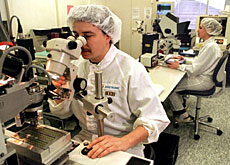Diabetes among the young causes concern

World Diabetes Day on Friday aims to focus attention on a disease that affects five per cent of the world’s population and is becoming more prevalent.
More than 250,000 people in Switzerland are registered diabetics, and the growing incidence of Type Two diabetes – particularly among young people – is causing alarm.
If present trends continue, the World Health Organization estimates the figure will rise to 300,000 in 2025.
“Ten years ago, you would never see Type Two diabetes in children,” biologist Pierre Maechler from Geneva University Medical School told swissinfo.
“It’s most probably a combination of eating habits and lack of exercise.”
Obesity
The causes of diabetes are still a mystery but recent studies have shown a connection with obesity.
In Geneva alone, ten per cent of schoolchildren are overweight and two to three per cent are obese – according to the body mass index, which is calculated as weight in kilograms divided by height squared.
When the figure is between 25 and 30, a person is considered overweight and when this value is over 30, health experts talk about obesity.
“There’s an increase in the level of obesity not only in Switzerland,” said Richard James, who works in the endocrinology and diabetes division of Geneva’s cantonal hospital.
“This is a worldwide problem and one of the major problems now is that we are seeing diabetes of Type Two, which was referred to as diabetes of the old, in youngsters of 15, 16, 17 years of age.”
Heart failure
At Geneva University, researchers are investigating different aspects of the illness.
Maechler’s team is examining how the beta cells in the pancreas secrete insulin and how our muscles and other tissues absorb glucose (sugar) from our blood.
Insulin is vital for life. Without it our bodies cannot obtain the necessary energy from food.
Over at the cantonal hospital, James is trying to understand why 80 per cent of diabetic patients die of heart disease and stroke.
“What we’re trying to understand is why in the face of what appear to be not too excessive lipid [fatty acid] levels in the blood, these diabetic patients nevertheless have such a huge excessive risk of cardiovascular disease,” he told swissinfo.
Transplantation
Meanwhile, Domenico Bosco is working in the laboratory of islet transplantation.
Islets are clusters of cells in the pancreas that make insulin. In people with Type One diabetes, islet cells are destroyed.
In islet transplantation, islets are taken from a donor pancreas and implanted in another person. Once implanted, the beta cells in these islets begin to make and release insulin.
“We hope that islet transplantation will help people with Type One diabetes live without daily injections of insulin,” explained Bosco.
Rejection is the biggest problem with any transplant, and recipients need to take drugs to stop the immune system from rejecting the transplanted islets.
Researchers like Bosco are looking at approaches that will allow successful transplantation without the use of immunosuppressive drugs.
Another key issue is the shortage of islet cells. Scientists are particularly excited by the prospect of using stem cells to create islet cells.
Rising cost
Diabetes can lead to a number of serious conditions and complications such as cardiovascular disease, kidney failure, blindness and nerve damage.
As the number of people with diabetes grows, the disease takes an ever-increasing proportion of national health care budgets.
Last year, a survey of nearly 1,500 diabetics in Switzerland revealed that the average cost of treatment per patient works out at SFr3,500 ($2,604) a year.
Extrapolating from these figures, the study concluded that the treatment of diabetes in Switzerland costs SFr1 billion a year.
Slow symptoms
The WHO estimates that the number of diabetics worldwide is likely to increase from 180 million to at least 300 million by 2025.
Type Two diabetes often develops slowly and the symptoms can be so mild that they go unnoticed.
It is thought that millions of people worldwide suffer from Type Two diabetes without realising it.
Researchers say early detection by testing for high blood sugar could avoid more serious health problems later.
Above all, they urge prevention through regular exercise and a healthy diet.
swissinfo, Vincent Landon
Diabetes is a disease in which the body does not produce or properly use insulin.
Insulin is a hormone that is needed to convert glucose (sugar) in the blood into energy.
Type One diabetes develops when the insulin-producing cells in the pancreas have been destroyed, and generally affects younger people
In Type Two diabetes – the most common form – the body cannot use its own insulin effectively or does not produce enough insulin.
It usually occurs in people who are over 45 and overweight.
The World Health Organization estimates that 300 million people will have diabetes by the year 2025.

In compliance with the JTI standards
More: SWI swissinfo.ch certified by the Journalism Trust Initiative


You can find an overview of ongoing debates with our journalists here. Please join us!
If you want to start a conversation about a topic raised in this article or want to report factual errors, email us at english@swissinfo.ch.